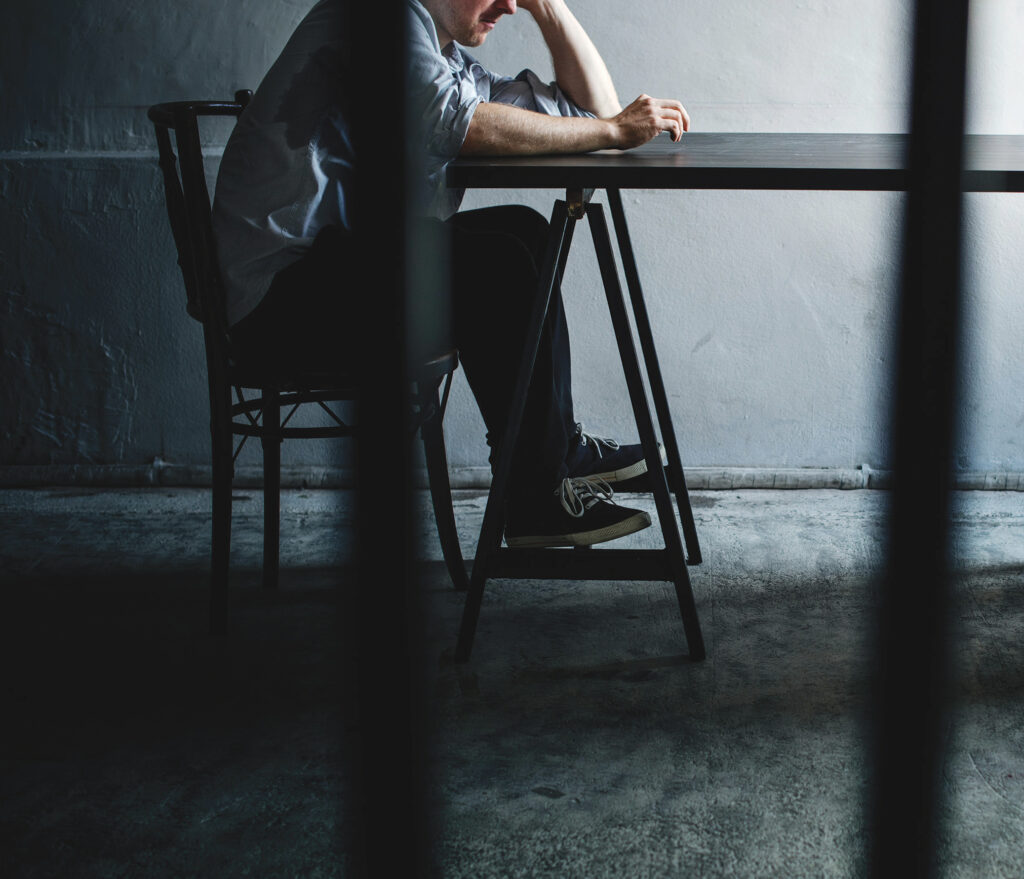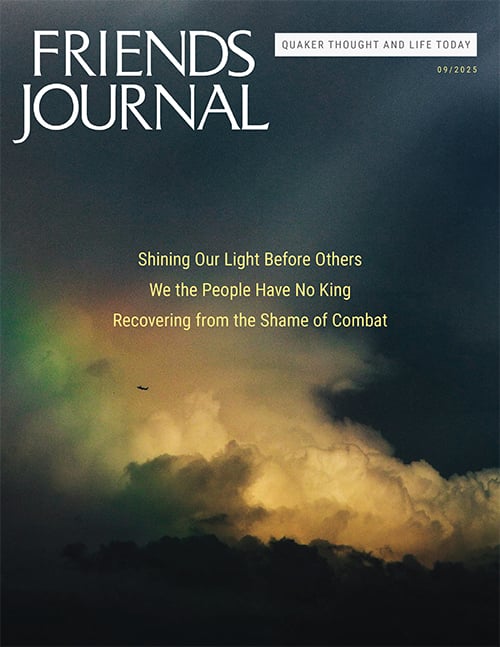Encounters Between Quakers and Incarcerated People
Quaker convictions about care for others and nurturing the Divine in everyone motivate Friends to visit, worship with, and educate people living in prison. Seeing the strengths of incarcerated people stems from Quaker spirituality.
“There is goodness and God in everyone, and there is Light in everyone,” said Liz Lesher, a Prisoner Visitation and Support (PVS) volunteer coordinator who visits the Federal Correctional Institution El Reno in El Reno, Oklahoma. Lesher is a member of Little Rock (Ark.) Meeting. She joins worship online from her home in Edmond, Oklahoma.
PVS was established in 1968, building on Friends’ history of concern for people in prison. It started as an organization to support Vietnam War-era conscientious objectors who were incarcerated. In the early 1970s, it expanded to provide visitors for other federal prisoners. Headquartered in Philadelphia, Pennsylvania, PVS trains and sends visitors into prisons across the United States.
Many Friends who interact with incarcerated people describe a calling that helped them grow spiritually. Tom Slick, who chairs the board of PVS, initially felt judgmental toward people in prison but grew more open and compassionate as he explored a spiritual leading to work with them.
“It’s being guided by the Spirit that got me into this,” said Slick, who worships at Second Street Community Church, a Friends church in Newberg, Oregon.
Some Quakers believe contemporary Friends should address harms caused by past Friends involvement in developing prisons. According to Bill Allman, an attender at Richmond (Va.) Meeting who visits prisoners through PVS, Quakers have a particular moral obligation to visit prisoners to make amends for earlier Friends who promoted solitary confinement.
Friends in the 1700s considered solitary confinement an alternative to physical punishments, such as whipping, branding, and executing, according to Eamonn Gearon, a Quaker historian who worships with incarcerated men at Southern State Correctional Facility in Springfield, Vermont. These Quakers thought solitude gave incarcerated people the opportunity to reflect on their deeds and to connect with that of God within. Solitary confinement, however, causes psychological damage and shortens life expectancy, according to the National Alliance on Mental Illness.
Other Friends place their commitment to prison visitation in the context of world history. “We think about other countries where gulags exist, where people are incarcerated never to be seen again. So it was very important to me that we maintained the ability to go into the prisons,” said former PVS volunteer Rachel Osborn of Lehigh Valley Meeting in Bethlehem, Pennsylvania. Gulags were forced labor camps in which the Soviet Union incarcerated dissidents and other convicts during the 1920s and 1930s.

Friends who work with incarcerated adults seek to acknowledge the positive traits and personal journeys of those who live in prisons. Friend Joyce Hinnefeld of Lehigh Valley Meeting is a retired professor from what is now Moravian University (formerly Moravian College) who established writing partnerships between her college students and incarcerated women. She noted that her students expected those in prison to be radically unlike themselves. In contrast, they found that many of the women in prison are accomplished and smart. Students in Hinnefeld’s Writing as Activism class exchanged narratives with and participated in other writing projects in partnership with women in the Northampton County Jail in Easton, Pennsylvania, as well as the State Correctional Institution at Muncy, Pennsylvania.
Hinnefeld’s students discovered that women in prison were on journeys of personal development. “They take full responsibility. They’re not pleased with themselves, but they’re trying to heal,” Hinnefeld said. She is currently program facilitator at Shining Light, an organization that involves incarcerated people in writing, making films, and writing plays.
Although incarcerated students are often bright and capable, their environment creates limitations. People in prison often cannot do homework because of the relentless noise in the facility, according to Hinnefeld. Hinnefeld has sent educational materials to women living in the state prison in Muncy. Prison regulations prohibit staples and paper clips, so she has to make and send copies of loose pages of readings, which can result in disarray when the mailings are opened.
In 2007, Ruth Brelsford began teaching college-level public speaking at a minimum security prison in McAlester, Oklahoma. “I found those students to be intelligent, curious, committed to the quality of their speeches, and pretty universally dedicated to a new life when they returned to the ‘free world,’” Brelsford said.
Brelsford previously taught composition, speech, and theater appreciation at the prison until college classes were discontinued. She wanted to continue teaching the incarcerated men, so she established a creative writing class in collaboration with the prison chaplain, Don Perteet. The class is non-religious but is held in the facility’s chapel.
Some Friends feel called to educate incarcerated people; others follow a leading to share Quaker worship with them. Devon Kurtz, previously an attender at Hanover (N.H.) Meeting, has an academic background in criminal justice and planned to work as a prison chaplain. He had also previously done restorative justice work. A representative of American Friends Service Committee spoke at his meeting about life in prisons. In 2022 and 2023, Kurtz collaborated with the Vermont Department of Corrections to start a Quaker worship group at Southern State Correctional Facility, a men’s prison in Vermont. Kurtz worked with incarcerated Quaker Rein Kolts on Sketches from Behind Prison Walls, a book containing Kolts’s drawings of other imprisoned people.
About five regular worshipers joined the meeting, including one who was already a Quaker, according to Kurtz. During the first 15 minutes of a meeting for worship, each person would share writing that had inspired him. Some books that Kurtz found particularly inspiring, from which he shared insights with those in prison, included The Journal of John Woolman; Quaker Spirituality: Selected Writings, written by various authors; and Prisoners in the Bible by Zach Sewell.
The literacy rate in prison is extremely low. One imprisoned man ultimately had to get his leg amputated because he could not read: he could not fill out medical slips to request care, Kurtz explained. Realizing there was a low literacy rate prompted Kurtz to reconsider having part of worship center on reading.
“You have to be charitable with yourself,” Kurtz said of his previous unfamiliarity with the impact low literacy had upon participation in worship.
The sharing time was followed by a half hour of silent worship and 20 minutes of closing thoughts. Worshipers talked about current events, prison conditions, and pending lawsuits filed by those in prison, Kurtz explained. In only two instances did conversation turn to worshipers’ offenses; some worshipers were sex offenders who attacked children. “It’s a very stigmatized group,” said Kurtz, who currently attends Salt Lake Meeting in Murray, Utah.
Eamonn Gearon, an attender at Hanover Meeting, began to convene the worship group at the Vermont prison after Kurtz left. Many incarcerated people who attend meeting for worship do so because silence is precious and rare in prison, according to Gearon. People living in prisons endure the constant noise of slamming doors, conflicts, and jangling keys. “They enjoy the silence,” said Gearon, who is also a member of Oxford Meeting in England.
Quaker convictions about care for others and nurturing the Divine in everyone motivate Friends to visit, worship with, and educate people living in prison. Seeing the strengths of incarcerated people stems from Quaker spirituality.
Receiving visitors helps incarcerated people feel less isolated and offers them opportunities for self-expression. “I think they need somebody from outside to even say ‘hello’ to them. I’m a good listener. I can sometimes give advice, but basically I’m listening and saying that I’m there,” said former PVS visitor Nicholas Butterfield of Lehigh Valley Meeting.
Daily life in incarceration involves an accumulation of indignities, according to Kurtz. One imprisoned man lost his dentures and did not get them back for several months. “It’s hard to imagine the level of deprivation,” Kurtz said.
Liz Lesher met with an incarcerated man with a mental impairment who was placed in solitary confinement. She ensured that he received visits from PVS volunteers at least twice a month due to the mental health impact of solitary confinement. “We have been able just to have access to the warden to ask that they really look at the file of this man and transfer him somewhere appropriate where the mental health issues will be addressed,” Lesher said.
Training and spiritual support enable people who are not incarcerated to interact effectively with people living in prisons. PVS trains volunteers at national conferences, through individual mentoring, and with a training manual that David Poundstone helped write. Poundstone is a Friend who previously served on the PVS training team and as a recruiter. The manual is explicit and concrete; it describes processes step-by-step. For instance, in some facilities, when visitors enter the prison, they can take in only two rolls of quarters but nothing else. The only thing they are allowed to write to people in prison are postcards that state the times and dates of upcoming visits. Poundstone is a member of Mountain View Meeting in Denver, Colorado.
The trainings help volunteer visitors respond to inappropriate requests and expectations. On volunteers’ first visits, they are sometimes asked by people in prison to bring in contraband or run illegal errands outside the facility, Bill Allman noted. Incarcerated people often expect visitors to proselytize, which PVS volunteers do not do. Weekly Quaker worship and Catholic Mass provide the spiritual support Allman needs to persist in his work with prisoners.
Devon Kurtz relied on an anchor committee of Friends from his meeting to help him process his emotional reactions to working with men convicted of sexual offenses. Members of the anchor committee had committed themselves to hear upsetting things that Kurtz thought would be too burdensome for conversations with friends who had not made such a commitment. One man who was incarcerated shared that he lived with a mental health disorder that caused him to intentionally harm himself, such as spraying himself with an officer’s pepper spray or by splashing scalding water on his own face.
Other practices can help volunteers handle the stress that comes with visiting the incarcerated. Poundstone copes with the suffering he hears while visiting imprisoned people by debriefing with another volunteer visitor.
Through her work at Shining Light, Hinnefeld participates in sessions with incarcerated people that begin with them reflecting on what went right with their days and continue with a focus on gratitude, she explained. Such reflections and focusing are spiritual practices that people who are not incarcerated can adopt to sustain themselves when working with those in prison.
Prayer also offers peace when one is connecting with people in prison who share stories of trauma. “I pray when I’m anxious. I was sort of praying all the time,” Hinnefeld said.





Comments on Friendsjournal.org may be used in the Forum of the print magazine and may be edited for length and clarity.